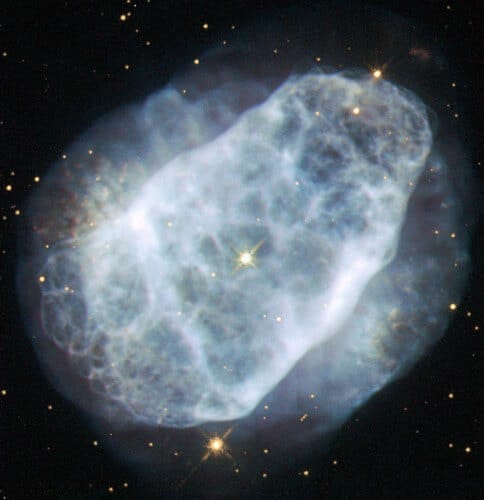In a nebula which is actually a sun shedding its outer layers, there is 5 times more nitrogen and 3 times more neon, argon, oxygen, carbon and chlorine. The assessment: these elements were already in the nebula from which the star was formed

The Hubble Space Telescope photographed the planetary nebula NGC 6153 which is about 4,000 light-years away in the constellation Scorpius.
The light blue nebula that borders the image shows what the remains of a Sun-like star looks like after it has consumed most of its nuclear fuel. When this happens, the outer layers of the star are ejected and accelerated and ionized by the ultraviolet light emitted by the star's hot core, which created the nebula.
NGC 6153 is an elliptical planetary nebula containing a large network of loops and filaments, clearly visible in this Hubble image. However, this is not what makes the nebula so interesting for astronomers.
The measurements made by the researchers who analyzed the image showed that NGC 6153 contains a large amount of neon, argon, oxygen, carbon and chlorine - at a level three times higher than the concentration of these substances in the solar system.
The nebula contains 5 times more oxygen than our sun. It is possible that the star developed high levels of these materials during its development and growth stages, but it is likely that the star was originally formed from a cloud of materials that already contained large concentrations of these elements.

4 תגובות
Zuri
Yes, the Hubble returned the investment in it dozens if not hundreds or thousands of times. It is difficult to describe the amount of knowledge that has been gained about the universe with his help. And beyond that, if I may be lyrical for a moment, the images he provides are the stuff dreams are made of.
Zuri
And if you ever visit an academic institution, the ministry of culture or a museum, you will discover that many actions of people do not "hold investment"
It is important that you understand two things: 1. Before science becomes applicable (makes money) there is a long and theoretical phase of pure research.
The study of electricity was a theoretical pursuit for a long time before anyone made money selling microwaves.
2. There is enormous importance in research in itself
Everything - does this beauty also give something? (Not that I'm disparaging - beauty inspires curiosity, which inspires research. But today - does the money spent on it return the investment?)
Pretty